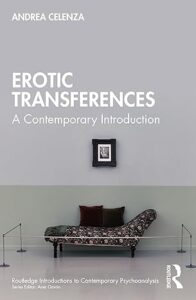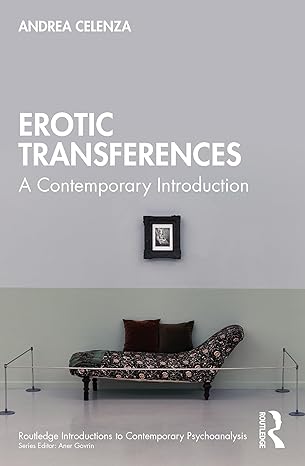 by Andrea Celenza, Ph.D
by Andrea Celenza, Ph.D
This book offers a comprehensive introduction to this key, yet challenging aspect of the psychoanalytic process. Despite emerging frequently in the psychoanalytic process, Andrea Celenza highlights the sparseness of literature on erotic transferences and a tendency to desexualise psychoanalytic theorizing, which she posits is a result of the inherent threat erotic transferences can pose to the analyst. By providing a thorough overview of the topic, clarifying terminology, and providing vivid case examples, Celenza seeks to redress this omission. Throughout this volume, she discusses the interplay of power and gender, along with chapters on the temptation of disclosure and the disturbing prevalence of sexual boundary violations. Providing practitioners with the tools to deal with the intense feelings that inevitably arise with erotic transferences, this book is vital reading for all psychoanalysts at all levels of experience and seniority, psychodynamic practitioners, instructors, candidates, and trainees.
Epistemologically, Celenza takes an intersubjective, social-constructivist approach and, therefore, describes clinical manifestations that reflect this underlying foundation. On a clinical level, she takes seriously all of the psychoanalytic approaches to emergent phenomena, including neo-Classical, neo-Kleinian, Object-Relational, Relational, and Post-Bionian Field Theoretical systems. The latter especially permeates her understandings of the role of countertransferences as this vantage point provides an essential channel for unconscious communication. All of these perspectives are organically interwoven into pertinent case illustrations.
This book is part of a series by Routledge comprised of dozens of books that will serve as concise introductions dedicated to influential concepts, theories, leading figures, and techniques in psychoanalysis. All volumes are characterized by “clarity, accessibility, and depth.” The purpose of the series is to offer compendia of information on particular topics within different psychoanalytic schools. These books make intricate ideas comprehensible without compromising their complexity. The aim is to make contemporary psychoanalysis more accessible to both clinicians and the general educated public.
Table of Contents
- Introduction
- What are erotic transferences?
- Maternal erotic transferences
- The erotics of power
- Are erotic transferences gendered?
- Comfort and containment of erotic language and feelings
- Erotic transferences and sexual boundary violations
Reviews
“Andrea Celenza explores in this seminal book one of the most difficult – and not surprisingly least visited – theoretical/clinical areas of psychoanalysis from its beginnings to the present. With her long specific experience in observing and treating these often highly problematic transference configurations, she succeeds in clearly describing their variety and complexity. Erotic transference is thus transformed, in many cases, from insurmountable obstacles to treatment into valuable opportunities for ever deeper and more effective analysis at the heart of human sometimes dramatic relational experience.”
Stefano Bolognini, MD; IPA Past-President; author of Vital Flows Between Self and Non-Self: The Interpsychic, (Routledge, 2022).
“Erotic transferences are ubiquitous. However, they are often denied, buried, projected, dismissed, overlooked, feared, or hidden in the darkest corners of the psyche. In this outstanding tour de force, Andrea Celenza brings them out of the darkness and into the daylight. In so doing, she enlightens her readers while also providing the reader with a brilliant guide. I highly recommend it to clinicians and educators alike.”
Glen O. Gabbard, MD, Clinical Professor of Psychiatry, Baylor College of Medicine, author of Boundaries and Boundary Violations in Psychoanalysis (American Psychiatric Publishing, 2016).
“I thought I knew a lot about this topic, but I learned many new things from this lucid, accessible and stimulating book. Andrea Celenza is right that psychoanalysis has been desexualised. As one of the foremost experts on sexual misconduct, she now places that phenomenon in the much larger and more positive context of the erotic dimensions of psychotherapy. What she writes will be essential reading for therapists of all schools and at all levels of experience.”
Prof. Andrew Samuels, author of A New Therapy for Politics? (Routledge, 2019) and From sexual misconduct to social justice (Psychoanalytic Dialogues, 1996).
“Andrea Celenza brings together in this contemporary volume her years of expertise in the areas of sexuality and erotic life within psychoanalysis. Written in an accessible style, this book will be a valuable resource for both clinicians in training and those already in practice. Celenza’s evocative depiction of both the challenges and the creative potential of engaging the erotic in clinical work will stir deepening reflection on this crucial, yet neglected topic.”
Dianne Elise, PhD, author of Creativity and the Erotic Dimensions of the Analytic Field (Routledge, 2019).
“In Erotic Transference: A Contemporary Introduction, Andrea Celenza delves deeply and courageously into the often-avoided place of sexuality and the erotic in psychoanalysis. Skillfully defining the various forms of erotic transference, Celenza looks the desexualization of our field in the eye, as she addresses our transgressions, fears and vulnerabilities. A powerful and important volume that brings sexuality and eroticism back into psychoanalytic theory and practice.”
Galit Atlas, PhD. Faculty NYU Postdoc, author of Emotional Inheritance: A Therapist, Her Patients and the Legacy of Trauma (Little, Brown Spark, 2023).
“Andrea Celenza brings back to the fore what psychoanalysis started on, repressed sexuality. The need for such a book, examining in depth the multiple causes to a desexualization in psychoanalytic theory, in spite of its continuous presence in the interplay of transference and countertransference, is critical for addressing the centrality of the body as reflected in the mind in the psychoanalytic process. This book does a great service to our profession.”
Rachel Boué-Widawsky, PhD, IPTAR, Clinical Assistant Professor at NYU Medical School, Associate Editor of Journal of Psychoanalytic American Association.

